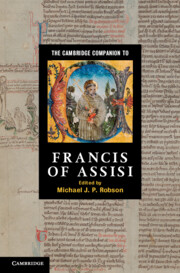Book contents
- Frontmatter
- Introduction
- PART I Francis of Assisi
- PART II The heritage of Francis of Assisi
- 10 Francis and the pursuit of learning
- 11 The early Franciscans and the towns and cities
- 12 The Third Order of Francis
- 13 Franciscan ideals and the royal family of France (1226–1328)
- 14 Franciscans as papal and royal envoys to the Tartars (1245–1255)
- 15 Franciscan missions
- 16 Pope John XXII, the Franciscan order and its Rule
- 17 The ecumenical appeal of Francis
- A guide to further reading
- Index
15 - Franciscan missions
from PART II - The heritage of Francis of Assisi
Published online by Cambridge University Press: 28 November 2011
- Frontmatter
- Introduction
- PART I Francis of Assisi
- PART II The heritage of Francis of Assisi
- 10 Francis and the pursuit of learning
- 11 The early Franciscans and the towns and cities
- 12 The Third Order of Francis
- 13 Franciscan ideals and the royal family of France (1226–1328)
- 14 Franciscans as papal and royal envoys to the Tartars (1245–1255)
- 15 Franciscan missions
- 16 Pope John XXII, the Franciscan order and its Rule
- 17 The ecumenical appeal of Francis
- A guide to further reading
- Index
Summary
Brother Giles of Assisi was the first Franciscan to go as a missionary to the Muslims. He had become one of Francis's companions on 23 April 1208, joining soon after Bernard of Quintavalle. According to Thomas of Celano
[Giles] lived for a long time: he was holy, living justly and piously. He left us examples of perfect obedience, work, including work with his hands, solitary life and holy contemplation.
In 1209, when the number of brothers had increased to eight, Francis sent them out in pairs. Bernard and Giles journeyed to Santiago de Compostela, the pilgrimage site in Galicia in the north-west of the Iberian peninsula, where the apostle James, son of Zebedee and brother of John, was reputed to be buried. Santiago, as the Iberians called him, had become a rallying cry of the Christian warriors who since the eleventh century had fought in the Reconquest, the struggle to reconquer and christianise the peninsula from the northern mountains southwards.
According to the Shorter Life of Giles, he returned to Assisi from Santiago and then went to the shrine of St Michael on Monte Gargano and that of St Nicholas at Bari. Leo adds:
As [Giles] went about the world he urged men and women to fear and love the creator of heaven and earth and to do penance for their sins. One day, when he was thoroughly worn out and suffering from hunger, he slept by the roadside. He was awakened from sleep by the favour of God, who does not abandon those whose hope is in him, and Giles found half a loaf at his head. Giving thanks to God he ate and was sustained.
- Type
- Chapter
- Information
- The Cambridge Companion to Francis of Assisi , pp. 240 - 257Publisher: Cambridge University PressPrint publication year: 2011
- 1
- Cited by

